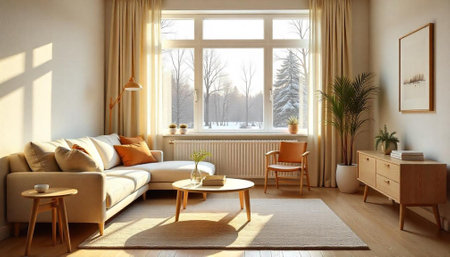Introduction to Minimalist & Scandinavian Design for Indian Homes
Minimalist and Scandinavian home design styles have captured the imagination of homeowners worldwide, thanks to their clean lines, calming palettes, and clutter-free approach. However, when it comes to Indian homes, these styles need thoughtful adaptation. India’s vibrant culture, multigenerational family structures, and diverse climates call for a unique blend that respects both function and tradition. Minimalism isn’t just about empty spaces; it’s about intentional living—keeping only what matters and letting your space breathe. The Scandinavian approach layers in warmth with natural materials, soft textures, and abundant light, creating a cosy yet elegant atmosphere. By embracing these principles with an Indian touch—think earthy tones, sustainable materials available locally, and smart space planning—you can achieve a home that feels spacious, welcoming, and uniquely yours. Whether you live in a compact Mumbai apartment or a sprawling Bengaluru villa, minimalist and Scandinavian makeovers can be tailored to fit your lifestyle and budget while honouring cherished cultural practices.
Smart Budget Planning for Home Makeovers
Embarking on a minimalist or Scandinavian home makeover in India doesn’t have to strain your wallet. The key is to plan your budget smartly, prioritise essential upgrades, and seek cost-effective alternatives that suit Indian lifestyles. Here’s how you can achieve a beautiful transformation without overspending.
Setting a Realistic Budget
Begin by evaluating your total available funds for the project. Consider factors such as family needs, seasonal festivals, and upcoming commitments. Set aside a contingency amount (typically 10-15%) for unexpected expenses common during home renovations in India.
| Expense Category | Estimated Percentage of Total Budget | Indian Market Tips |
|---|---|---|
| Paint & Wall Finishes | 20% | Choose local brands or washable distemper for durability |
| Furniture & Decor | 40% | Look for handcrafted pieces from Indian artisans or second-hand options |
| Lighting & Fixtures | 15% | Opt for LED bulbs and energy-efficient fixtures easily available in local markets |
| Soft Furnishings | 15% | Select cotton or jute items made in India for style and affordability |
| Miscellaneous & Contingency | 10% | Cushion for repairs or last-minute changes; always negotiate prices! |
Prioritising Key Changes
Identify which areas will create the biggest impact while staying within budget. For example, updating wall colours to neutral tones, decluttering spaces, and introducing multi-purpose furniture can instantly add a Scandinavian touch without major expenditure. In Indian homes, focus on living rooms and entryways where guests are welcomed — these areas offer maximum visibility for your makeover efforts.
Finding Cost-Effective Alternatives in Indian Markets
The beauty of decorating in India is the wealth of local resources. Explore city markets and online platforms like Pepperfry, Urban Ladder, or even OLX for pre-loved furniture. Replace expensive Scandinavian imports with locally made wooden pieces or upcycled furniture found in your city’s bazaars. Use DIY hacks with jute ropes, terracotta pots, and block-printed textiles to mimic Nordic minimalism while celebrating Indian craftsmanship.
Pro Tip:
Bargaining is an art in Indian shopping culture—don’t hesitate to negotiate prices whether you’re buying new or second-hand items! By being mindful about every rupee spent, you can achieve a stylish and functional home that reflects both Scandinavian calm and Indian warmth.

3. Choosing the Right Colours and Materials for Indian Conditions
When planning a minimalist and Scandinavian-inspired makeover for your Indian home, selecting the right colours and materials is key to achieving both style and practicality. The classic Scandinavian palette is known for its earthy, muted tones—think soft greys, gentle beiges, whites, and cool blues. These shades work beautifully in Indian homes, helping to create a sense of calm and openness even in compact spaces. For Indian conditions, it’s wise to opt for lighter hues that reflect heat and keep interiors feeling fresh during hot months.
Embracing Earthy Scandinavian Palettes
To create a harmonious look, choose wall paints in off-white, pale grey, or sandy beige. Accent walls in pastel blue or sage green can add a subtle pop without overwhelming the space. Consider using natural finishes like lime plaster or textured paints that are better suited to our climate and resist humidity.
Sourcing Durable & Affordable Local Materials
Scandinavian design celebrates simplicity and nature, which aligns well with Indian craftsmanship. Choose local woods such as teak, mango wood, or sheesham for furniture—they’re not only sturdy but also budget-friendly compared to imported options. For textiles, opt for breathable materials like pure cotton or khadi; these are widely available across India and keep your home cool while adding an authentic touch.
Practical Tips for Material Shopping
Visit local markets or trusted carpenters for custom furniture made from native woods—this supports small businesses and lets you control quality and cost. When shopping for curtains or cushion covers, look for cotton or handwoven khadi fabrics at government emporiums or online platforms like FabIndia. These materials are not just affordable but also sustainable and easy to maintain in the Indian context.
By combining Scandinavian colours with Indian materials, you create a comfortable home that stands up to local weather while embracing timeless global design trends—all without stretching your budget.
4. Maximising Space in Compact Indian Homes
Living in compact apartments or joint family homes is a common reality for many Indian families, especially in metro cities. Embracing budget-friendly minimalist and Scandinavian principles can make your space feel larger, brighter, and more welcoming—without sacrificing functionality or your unique Indian way of living.
Decluttering: The First Step to Spacious Living
Start by decluttering spaces room by room. In Indian homes, we often accumulate extra utensils, decor items, and gifts over the years. Follow these simple tips:
- Sort & Donate: Keep only what you need or truly cherish; donate the rest to local NGOs.
- Organise by Category: Group similar items together for easy access and less visual chaos.
- Routine Checks: Set aside a weekend every few months for a quick declutter session.
Choosing Multi-Functional Furniture
Selecting furniture that serves multiple purposes is essential for small Indian apartments. Here’s a quick guide to popular options:
| Furniture Item | Main Use | Secondary Function |
|---|---|---|
| Sofa-cum-bed | Sitting area | Guest bed during festivals/family visits |
| Nesting tables | Coffee table | Extra seating during gatherings |
| Storage ottomans | Footrest/seating | Toys, books, or linen storage |
| Foldable dining set | Dining space | Easily stows away when not needed |
| Wall-mounted shelves | Display decor/books | Keeps floor uncluttered for easy cleaning (especially helpful in joint family homes) |
Space-Optimising Layouts for Indian Living
The layout of your home plays a big role in how open and comfortable it feels. Here are some practical layout ideas tailored for Indian lifestyles:
- L-shaped seating: Ideal for drawing rooms, accommodates more people during family gatherings without blocking pathways.
- Zoning with rugs: Use rugs to visually separate pooja areas, study corners, or children’s play zones—without adding walls.
- Tall cabinets: Make use of vertical space for storing extra bedding, utensils, or seasonal items.
- Create flexible spaces: Use curtains or folding screens to temporarily divide rooms when privacy is needed (useful for joint families).
- Avoid heavy partitions: Opt for open shelves or glass dividers instead of full walls to let light flow through the home.
Embracing Minimalism the Indian Way
You don’t have to give up cultural elements—display brass diyas, terracotta pots, or handloom throws sparingly for warmth and personality. Remember, the goal is to keep what matters most while ensuring every item has its place. Through smart decluttering, multi-functional furniture choices, and thoughtful layouts inspired by Scandinavian minimalism yet rooted in Indian practicality, even the smallest flat can become an inviting and spacious haven for your family.
5. Blending Scandinavian Minimalism with Indian Accents
Striking the perfect balance between Scandinavian minimalism and Indian heritage can transform your home into a unique, soulful space without breaking the bank. The clean lines and neutral palettes of Scandinavian design provide an excellent canvas for infusing vibrant Indian touches that reflect your roots and personal style.
Celebrating Indian Craftsmanship in Minimalist Spaces
One of the most budget-friendly ways to add warmth and character is by incorporating traditional Indian crafts. Handloom textiles—think soft cotton dhurries, ikat cushion covers, or kantha throws—bring texture and subtle colour to otherwise muted interiors. Opt for a few statement pieces instead of overcrowding, allowing each item to shine within the minimalist theme.
Block Prints: Subtle yet Striking
Introduce block-printed curtains, table runners, or bedsheets in earthy tones for a touch of desi flair. These handcrafted fabrics blend seamlessly with Scandinavian whites, greys, and beiges while adding personality and cultural richness. Choose geometric or floral motifs that complement the minimalist aesthetic.
Brassware: Timeless Elegance
Accessorise with carefully selected brass items such as diyas, planters, or vases. Their warm metallic finish adds sophistication without overwhelming the space. Place a single brass lamp on a clean-lined console or use small brass bowls as catch-alls to maintain that clutter-free look.
Personalising Your Space with Heritage Elements
Display family heirlooms like traditional wooden boxes or vintage photographs in simple frames on open shelves. This not only personalises your home but also keeps it connected to your roots. Remember, minimalism is not about erasing your history—it’s about curating meaningful objects with intention.
Pro Tip: Less is More
Select just a handful of Indian accent pieces you truly love and let them stand out against the serene backdrop typical of Scandinavian interiors. This approach ensures your home feels balanced, inviting, and distinctly yours—where Nordic calm meets Indian vibrancy in every corner.
6. DIY Décor and Upcycling Tips
Transforming your Indian home into a budget-friendly minimalist or Scandinavian sanctuary doesn’t require expensive décor pieces. With a bit of creativity and resourcefulness, you can craft your own unique décor items while giving old furniture a fresh lease of life. Not only does this approach save money, but it also adds a personal touch to your space and supports sustainable living.
Affordable DIY Décor Ideas
Start by repurposing everyday household items. Old glass bottles can be turned into elegant vases with a coat of pastel paint or jute wrapping. Use discarded wooden trays as wall art by painting them in soothing Scandinavian tones like whites, greys, and light blues. Create macramé wall hangings using cotton ropes—these add both texture and that sought-after Nordic charm.
Upcycling Old Furniture with an Indian Twist
Give new life to worn-out furniture by sanding, painting, or stenciling them with simple geometric patterns inspired by traditional Indian designs like Warli or Madhubani art. Add cane webbing to old chairs for a blend of modern minimalism and classic Indian craftsmanship. Even a basic wooden table can be refreshed with a whitewash finish and adorned with hand-painted block prints for that subtle fusion vibe.
Support Local Artisans for Unique, Eco-Friendly Pieces
While DIY is rewarding, don’t forget India’s vast pool of talented artisans. Source handwoven rugs from local weavers in Panipat or Jaipur, or pick up pottery from your neighbourhood market. These handcrafted pieces not only lend authenticity and warmth but also align perfectly with the eco-friendly ethos of Scandinavian style.
Embracing DIY décor and upcycling isn’t just about saving money—it’s about telling your home’s story through meaningful, sustainable choices that celebrate both Scandinavian simplicity and Indian heritage.
7. Sustaining the Minimalist Lifestyle
Embracing minimalism in your Indian home is a wonderful first step, but maintaining this way of living requires gentle discipline and thoughtful routines. Here’s how you can keep your home clutter-free and your family invested in the minimalist, Scandinavian-inspired lifestyle—without straining your budget or losing touch with our rich Indian traditions.
Adopt Conscious Consumption
Before bringing anything new into your home, pause and ask: Do I truly need this? Can it serve multiple purposes? This mindful approach prevents unnecessary purchases and keeps clutter at bay. Encourage the whole family to choose quality over quantity, whether its buying a new kurta, a kitchen appliance, or even decor items for festivals.
Set Simple Decluttering Routines
Make decluttering a monthly ritual—perhaps at the start of each month or before major festivals like Diwali or Pongal. Involve everyone by assigning easy tasks: children can sort out toys, adults can review kitchen storage, and grandparents can help decide what to donate. These regular check-ins ensure that unused items don’t accumulate and that your space remains open and calming.
Create Dedicated Spaces
Assign a place for everything, from shoes near the entrance to daily prayer items on a neat shelf. Storage baskets, wall hooks, and labelled containers (all easily available at local markets or online) can help keep things organised without breaking the bank. When every item has a designated spot, tidying up becomes effortless for all family members.
Celebrate Simplicity Together
Minimalism doesn’t mean letting go of culture or tradition. Instead, celebrate important occasions with meaningful rituals rather than excessive decoration or gifts. For instance, use handcrafted diyas instead of elaborate lighting during Diwali or opt for simple rangoli designs using natural colours. These small changes add warmth while honouring tradition and sustainability.
Practice Gratitude Daily
A minimalist home thrives when its members appreciate what they have. Start a gratitude practice as a family—perhaps during evening chai time—by sharing something each person is thankful for in their space. This strengthens bonds and helps everyone cherish the beauty of simplicity.
Stay Flexible & Kind to Yourself
Your journey towards minimalism doesn’t have to be perfect. Some months will be messier than others, especially during festive seasons or school holidays. What matters most is your commitment to return to simplicity and not give up when things get challenging.
By weaving these routines and mindsets into daily life, Indian families can nurture both their homes and their hearts—finding joy in less, while staying connected to roots and relationships. Minimalism is not just about having less; it’s about making room for what truly matters.

